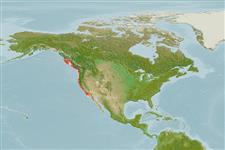>
Ovalentaria/misc (Various families in series Ovalentaria) >
Embiotocidae (Surfperches)
Etymology: Hyperprosopon: Greek, hyper = over + Greek, prosopon = face, snout of animal (Ref. 45335); ellipticum: From the Latin 'ellipticum' - referring to the outline of the body (Ref. 6885).
Environment: milieu / climate zone / depth range / distribution range
Ekologi
laut dasar (demersal); kisaran kedalaman 0 - 110 m (Ref. 2850). Subtropical; 56°N - 30°N, 135°W - 116°W
Eastern Pacific: southern British Columbia, Canada to Rio San Vincente, northern Baja California, Mexico.
Size / Weight / umur
Maturity: Lm ? range ? - ? cm
Max length : 27.0 cm TL jantan/; (Ref. 2850); Umur maksimum dilaporkan: 7 Tahun (Ref. 56049)
deskripsi pendek
Kunci identifiaksi (pengenalan) | Morfologi | Morfometrik
Duri punggung (Keseluruhan (total)) : 8 - 10; duri punggung lunak (Keseluruhan (total)) : 25 - 28; Duri dubur: 3; Sirip dubur lunak: 29 - 34. Dark green dorsally, sides and belly silvery; a series of narrow vertical bars of pale golden pink on body wall; pectoral fins colorless (Ref. 6885). British Columbia specimens dark on end of caudal fin and free edge of spinous dorsal (Ref. 6885).
Found inshore, in surf and sandy areas, also occur around rocks and piers (Ref. 2850). Intertidal and to 110 m (Ref. 96339). Viviparous, female carries the developing young (Ref. 205). Frequently caught, but not of much importance as a sport fish due to its small size (Ref. 2850).
Viviparous, female carries the developing young (Ref. 205).
Eschmeyer, W.N., E.S. Herald and H. Hammann, 1983. A field guide to Pacific coast fishes of North America. Boston (MA, USA): Houghton Mifflin Company. xii+336 p. (Ref. 2850)
Status IUCN Red List (Ref. 130435: Version 2024-2)
ancaman kepada manusia
Harmless
penggunaan manusia
Perikanan: komersial; Ikan buruan: ya; Akuarium: Akuarium publik
Alat, peralatan
laporan khas
muat turun XML
Sumber internet
Estimates based on models
Preferred temperature (Ref.
123201): 8.3 - 12.8, mean 9.8 °C (based on 64 cells).
Phylogenetic diversity index (Ref.
82804): PD
50 = 0.6250 [Uniqueness, from 0.5 = low to 2.0 = high].
Bayesian length-weight: a=0.01905 (0.00827 - 0.04391), b=2.97 (2.77 - 3.17), in cm total length, based on LWR estimates for this (Sub)family-body shape (Ref.
93245).
Trophic level (Ref.
69278): 3.3 ±0.5 se; based on size and trophs of closest relatives
Daya lenting (Ref.
120179): sedang, Waktu penggandaan populasi minimum 1.4 - 4.4 tahun (tm=3; tmax=7).
Fishing Vulnerability (Ref.
59153): Low vulnerability (17 of 100).
